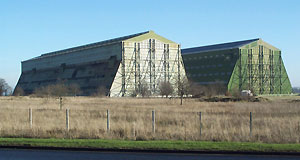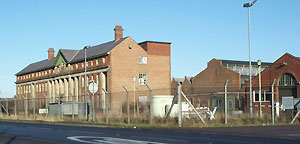|
 |
 |
 |
 |
 |
 |
 |
 |
 |
 |
 |
 |
 |
 |
 |
 |
 |
 |
 |
 |
 |
 |
 |
 |
|
|
|
|
|
|
|
|
|
|
|
|
|
|
|
|
|
|
|
|
 |
|
|
|
|
|
|
|
|
|
|
|
|
|
|
|
|
 |
|
In 1917 the Admiralty bought the Cardington site and commissioned Shorts Brothers to build
an airship factory and a community to accommodate the workers. The village became known as Shortstown. The first airship shed was built on the site that year, named 'Building 80', by A J Main and Co Ltd. In 1918 the launch of the R31 saw the beginning of Cardington's airship building. The Air Ministry took over the site in 1919 and in 1921 Cardington became known as the Royal Airship Works. From 1924 Cardington became the centre for the Imperial Airship operations. The R100 airship was built in Yorkshire and the decision was made to build another giant airship, the R101, at Cardington. Building 80 was extended at a cost of £105,000 to house the R101. With this completed, Cardington needed a second hangar and so one was dismantled at the Pulham Airship base in Norfolk and re-erected by the side of the original hanger at Cardington; it became known as Hangar Two. With both hangars completed, Cardington was able to house both the gigantic ships, the R100 and R101. With its innovative tower mast, Cardington became one of the worlds best airship facilities. |
|
|
|
|
|
|
 |
 |
|
|
|
|
|
|
|
 |
 |
|
|
|
|
|
|
|
 |
 |
|
|
|
|
|
|
|
 |
 |
|
|
|
|
|
|
|
|
|
|
|
|
|
|
|
|
|
|
|
|
 |
|
|
|
|
|
|
 |
|
|
|
|
|
|
|
 |
 |
|
|
|
|
|
|
|
|
|
|
|
|
|
 |
|
|
|
The R100 airship flew from Cardington to Montreal and back. Cardington itself served as a Customs Office for passengers making the return trip. On the morning of 5th October 1930 the R101 crashed on its maiden voyage in woods near Beauvais to the north west of Paris killing 48 people. In 1931 the Government decided to stop further airship development and the R100 was scrapped and sold for £450 despite its successful flight to Canada.
|
|
|
|
|
|
 |
|
|
|
|
|
|
|
|
|
|
|
|
|
Cardington became an RAF station in 1936, training men of the Royal Air Force and during the Second World War it manufactured a balloon barrage which helped defend British cities. From 1938-1967 the Balloon Development Establishment was based at Cardington; balloons were used for meteorological research. |
|
|
|
|
 |
|
|
|
|
|
 |
|
|
|
|
 |
|
|
|
|
In 1974 its current owners, the Building Research Establishment, took over. From 1974-1989 Cardington was also home to the Fire Research Station; it became the first Large Building Test Facility, testing fire alarm systems, controlled combustion of scale built houses and investigating how fires spread.
|
|
|
|
 |
|
|
|
|
After 83 years, RAF Cardington closed on 31 March 2000. A review of the MoD in 1997 recommended that Cardington be closed as part of a cost cutting exercise. |
|
|
|
|
|
|
|
|
|
|
|
|
 |
|
|
|
|
|
 |
|
|
|
|
|
 |
|
|
|
|
|
Bellway Homes acquired an option from the ministry to buy the 70-acre site and has submitted a plan to Bedford Borough Council for a mixed residential, commercial and community development providing 3,000 new homes. Bellway homes have been asked by Bedford Borough Council to provide a planning and development brief for the site. As with the Elstow Storage Depot, the Council wants to make sure the development is a mix of houses, industry and community facilities.
|
|
|
 |
|
|
|
|
|
Hangar One has been privately owned over the years. In 1999 it was put on a buildings at risk register as the grade two listed building had fallen into a state of long-term disrepair. Proposals have been put forward to turn the hangar into a museum. Although Hangar Two was refurbished in 1993 its owners are planning to sell the huge hangar as it takes too much looking after. In the future, the officially listed historic buildings may become a museum recording Cardington's history.
|
|
|
 |
|
Back to top |
|
|
|
|
|
|
|
|
|
|
|
|
|
|
|
|
|
|
|
|
 |
|
|
|
|
|
Moving back to airships, in July 2000 a revolutionary new British airborne vehicle was launched at Cardington. Known as SkyCat, it has been developed by the Bedford-based Advanced Technologies Group and combines state of the art lighter than air technology with advanced propulsion and landing systems, proving that Cardington is still at the forefront of airship technology.
|
|
 |
|
|
|
|
|
|
|
 |
|
|
|
|
|
|
|
|
|
|
|
|
 |
|
|
|
|
|
|
|
|
|
Put your mouse over the image and prepare to take off! Then click on the plane for a 'flying visit' of Marston Vale's industry section or click the text. |
|
|
|
|
|
|
|




